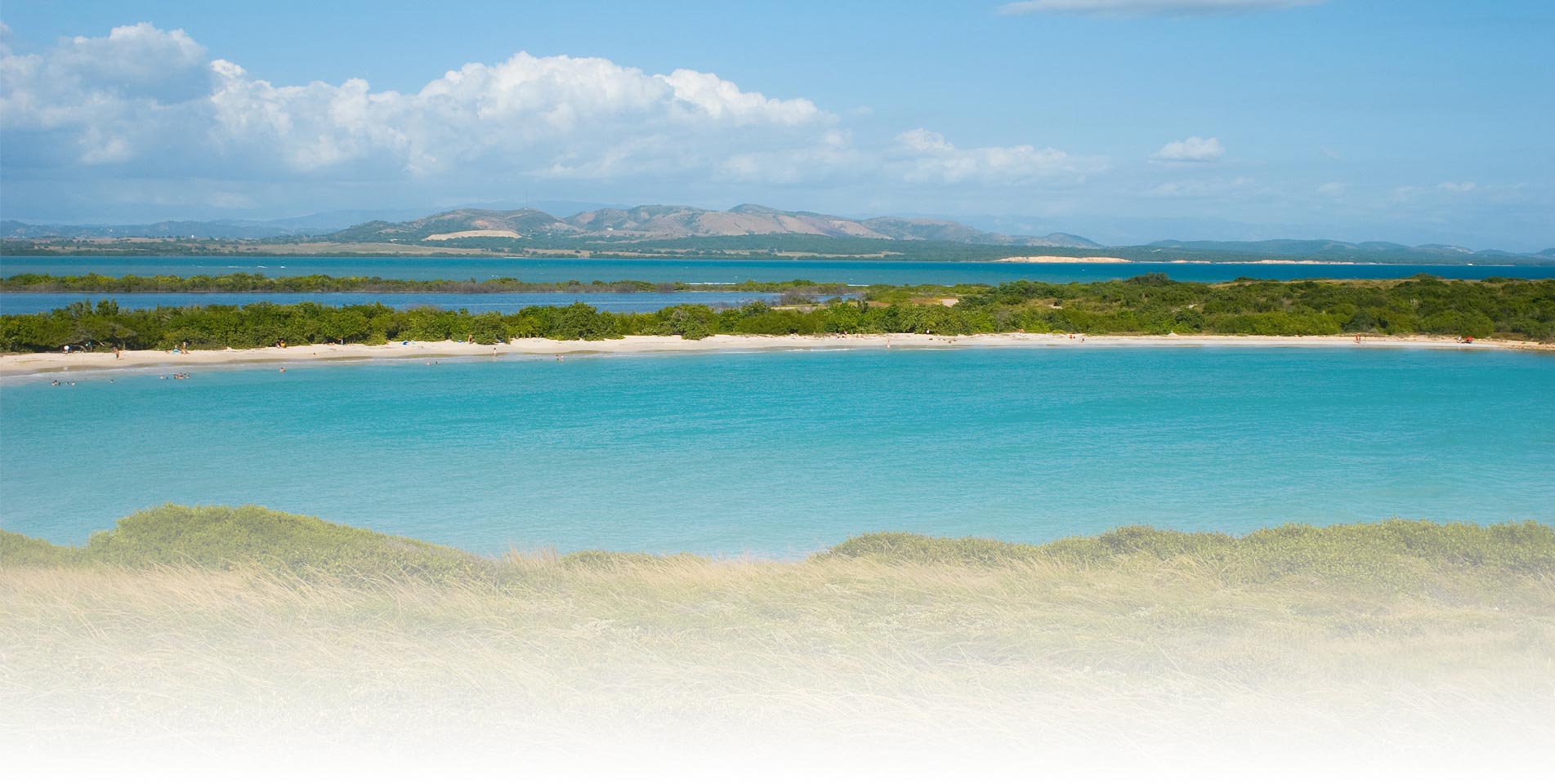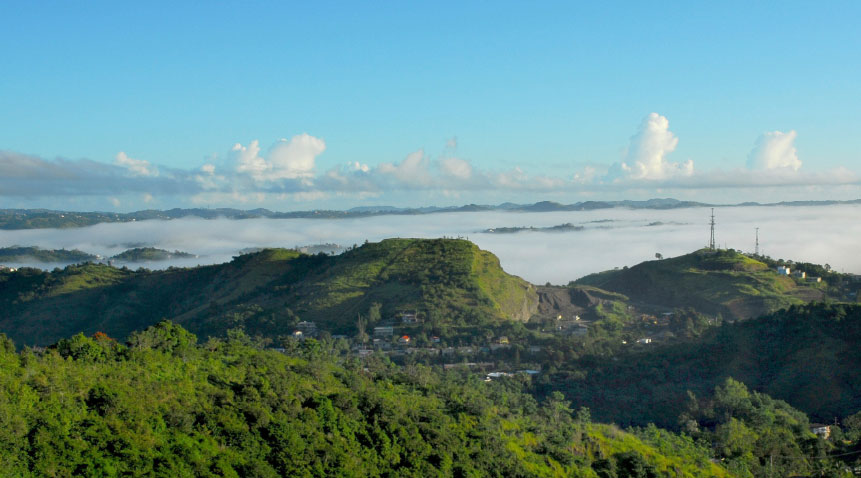
The best spots for Puerto Rican snack bites are often traditional food marketplaces, open air coastal or mountainside stands, modest country kitchens or downtown fondas, basic eateries that deliver delicious local food at reasonable prices.
Chasing their allure will take you from some off the beaten path spots in the downtown San Juan metro area to the glorious Humacao coast, and the lush, cool mountains of Barranquitas and Orocovis to the quaint waterfronts of Naguabo, and Salinas. So the chase is part of the fun, but you know from the first taste of one of these must try bites what the hunt is really all about.
But be forewarned, you will still be craving them long after that first bite.
Chicharron volao from Bayamon
Bayamon, the big suburb west of San Juan, hides a number of wonders among its shopping malls and large thoroughfares, many of them culinary. One of the crunchiest and tastiest is chicharron volao, the local version of this fried pork grind treat that is usually served with tasty local hogaza or cachete bread. There’s no better accompaniment to this salty delicious primal eating experience than a cold beer, or alternately a fresh fruit frappe. The volao version is especially thin and crunchy, and lacks the thick fat that can be found in the Chicharron Del Pais, which is also sold in Bayamon.
You can get it alongside traffic jammed boulevards and crowded shopping centers, while others are alongside country roads leading from town to the central mountains, and other bucolic respites within the city. Chicharron has been an important dish in Bayamon for more than 200 years, developed by a handful of local families. It was first perfected by slaves during the Spanish colonial error, who were thrown the pig skins from their overloads to use. They turned it into a delicacy in its own right, as well as used it to give life to other dishes. You can still buy this treat from colorful wooden street carts in Bayamon, but it’s also available in stores and restaurants.
Flavor is rarely this crunchy, and if you fall under its spell, it’s hard to stop.
Mojo Isleño from Salinas
Born in a south coast fishing village nearly a century ago, mojo isleño is a fabulous sauce, delicious on anything but created for the fresh Caribbean seafood caught offshore in its home in Salinas.
The light tomato sauce is sweet with herbs and red pepper, which mutes the deep undercurrent of sautéed garlic and onion, and a vinegary mix of olives, capers and other delicious bits, depending on who is doing the cooking. It’s perfect for the red snapper and other fresh fish, octopus, conch and fresh Caribbean lobster caught fresh daily in waters just off the coast, drawing out and refining their particular ocean flavors.
The best place to experience the full seductive power of mojo isleño is along the Salinas coast, lined with sun kissed modest and rustic eateries, many with open air eating areas right at the Caribbean shore. All those fresh sea platters are served here and served a la comida criolla style (that’s Puerto Rican home cooking).
The town claims ownership of the famous mojo isleño, including some of the restaurant owners in La Playa sector, where perhaps the greatest concentration of restaurants are located, many right on the coast of this fishing village. It was based on a recipe imported from the Canary Islands, but made local by several changes added some 78 years ago, which remain jealously guarded family secrets.
Restaurants include Ladi’s Place, El Dorado, La Barca, El Balcon del Capitan, el Pelicano, and Manati Eco Resort. They all have a winning combination of awesome views and relaxed ambiance, along with that flavorful special sauce that is one of the biggest successes in Salinas – Mojo Isleño. It really is aimed at elevating the flavor of seafood, but it’s good on other Puerto Rican delicacies, everything from tostones or arepas to barbecued chicken or pork.
Rellenos de Apio from Barranquitas
These stuffed root vegetables are warm comfort food, born in the beautiful mountain town of Barranquitas, one of its great accomplishments, despite its rich cultural and intellectual tradition.
The yellowish interior of the elongated root vegetable is ground and formed into a paste, then stuffed with picadillo, a tasty seasoned beef and pork hash with local herbs and seasonings. Like the best of Puerto Rico’s comida criolla, the filling is flavorful without being spicy. The apio (celery) is then formed into elongated half-moon shapes, then fried to golden perfection, crunchy on the outside, while firm and creamy inside surrounding the juicy picadillo. Its culinary experience as tactile as it is flavorful.
The birthplace of Puerto Rico’s first elected governor, Luis Muñoz Marin, Barranquitas is cosmopolitan among its mountain peers, with historic cathedrals and residences, cultural offerings, shopping and fine restaurants, many of which will serve this specialty. The rellenos de apio can also find them at picturesque wooden shacks selling food and drinks along the town’s country roads, as well as at roadside stands and downtown restaurants.
The annual Apio Festival in April is perhaps the best time to try this nutritious, long rooted tuber vegetable, which is one of the oldest cultivated crops in the Americas, and one of Puerto Rico’s most important harvests. The root vegetable is sold in myriad forms at different culinary tents set up at the festival, which also offers live music, arts and crafts, children’s activities and farm exhibits.
Pastelillos de Chapin from Naguabo
Every town in Puerto Rico with a bit of coast has at least one picturesque harbor, but Naguabo’s is arguably the prettiest. As you stroll through the rows of seafood kiosks in a harbor side plaza, the picturesque food shacks and fine restaurants, you will find the best of another ubiquitous Puerto Rico pleasure – Pastelillos Chapin.
Chapin is the island term for coffer fish, a tasty white fish that thrives in the warm waters off shore, and is a favorite filling for fried pastelillos around the coasts of Puerto Rico. The fish is fried with pulverized peppers, onions, garlic, herbs and tomato, then stuffed inside the delicate pastry and deep fried to perfection.
Whether it’s a quick stop at one of the waterfront food kiosks, or an appetizer for a larger meal at waterfront restaurant, make sure to have a pastelillo de chapin while here. It’s a great spot to try it for the first time, and fans will be smitten by the high quality, a point of town pride.
Lechon asado from Guavate in Cayey
One way to chase a perfect afternoon is taking a drive through the mountains south of San Juan to hunt for bite of fresh pork roasted on an open spit fire – a taste worthy of far more challenging sojourns. The pretty hamlet of Guavate (in the mountain town of Cayey) is your best bet for one of Puerto Rico’s premier traditional platters.
A mountain road ribbons through the sector, which spreads across the lush forest and surging mountain streams that comprise the Carite Forest, as it overlooks green valleys and the vast blue water beyond the coasts. The road is lined with lechoneras, open air restaurants that roast whole pigs and chickens on premises, and serve it up fresh with great Puerto Rican side dishes, and other delicacies.
Slow roasted for hours on an open flame after being seasoned with a balance of several local spices, the roast pork is tender, succulent and delicious; there is really no better way to describe the dining experience. A great variety of traditional side dishes and delicacies like morcilla sausage are also available. The establishments also have full bars, and sell fresh fruit frappes.
On weekend afternoons, bands also perform, playing Caribbean country music, with dancing commencing right after dinner.
Longaniza from Orocovis
Longaniza is a delicious island sausage made fresh from local ingredients jotted down in recipes that have been passed down through the generations. This is the food of Puerto Rico’s cool lush highlands, born in Orocovis, a dramatically situated Caribbean Shangri-La.
The Orocovis take on longaniza is the most celebrated in Puerto Rico, based on a centuries old recipe from southern Italy. The version that made the town famous, however, is said to date more specifically back to the 1930s, when the first local longaniza recipe was forged that became a local legend – and is said to influence current recipes.
The town has several restaurants that offer longaniza and other Puerto Rico delicacies, making the town a perfect spot for a long, day long drive for a meal. The town has been promoting a ruta de la longaniza, or longaniza route, that passes 16 of the best restaurants. Many of them have outdoor patios and offer great views of tropical floral splendor as a backdrop.
The Ruta winds along several different routes in a web of narrow rural roads, starting off with Route 155, but then weaving onto 156, 569, 143 and then 564, and this is all before deciding which way to head back. It’s a beautiful drive through lush mountains and cloud forest, passing along the majestic Toro Negro state park, surging mountain streams and pristine lakes.
Arepas de coco from Vieques
Arepas are delicate biscuit-like pastries, which are often served stuffed with fresh caught conch, red snapper or Caribbean lobster ceviche, as well as other delights like shrimp in a criolla tomato sauce. Don’t confuse these with the thicker South American cornmeal versions of the same name. No relation at all. These are as light as heaven.
The best homemade arepas, which hail from Puerto Rico’s eastern region, are great straight up – a light breakfast biscuit or on the go snack. And no arepa is finer than the arepa de coco made in the island town of Vieques. The coconut version from this beautiful island adds a hint of sweetness to the arepa, but it’s not overpowering, so it still has the ability to serve as a canvas for something larger without getting in the way. The arepa de coco will add just a hint of complexity to an arepa stuffed with conch ceviche, or a cod fish serenata. Chicken and steak are sometimes used as a filling, but the arepa was really created for seafood.
In Vieques, once hooked, you will be eating arepas de coco from morning until night. It makes the perfect complement to Puerto Rico’s rich and delicious local coffee, and you will find it at food stands by the beach for lunch and it’s liable to be an integral part of any number of dishes served at the rustic gourmet restaurants nestled in the island’s lush hilly interior. Try the food stands on Esperanza’s main harbor or at the entrance to Sun Bay. You’ll also find them in the eateries surrounding the ferry terminal downtown.
Granos from Humacao
Granos or granitos are a unique fried rice and cheese fritter created in Humacao and found almost exclusively in this east coast city. The half-moon shaped fried snacks are a favorite breakfast bite, another delicious pairing to a cup of deep flavored Puerto Rican coffee. You can find them from street vendors in the central plaza and across town and at some restaurants and stores.
The snack dates back over a century, and is unique among Puerto Rico’s fried snacks known as frituras in its unique use of rice and local queso de papa. Frying the delicacies is part of the art, since a real granito must be golden crisp on the outside and velvety smooth on the inside. But preparing the dough with long patient care is also part of the art of making these so delicious.
The family business, Los Granos, is a main force in the development of this culinary treasure. It has been specializing in their preparation since the 1950s, and a group of about a dozen siblings still divides the work of preparing up to 2,000 granos daily.
The company sells its goods from carts across the city, as well as direct to the public from its Patagonia sector headquarters. When family matriarch Doña Bartola Rodriguez died last year, the mayor of Humacao declared three days of mourning. There are other makers of this delicacy, including Granos Bartola. The city also holds a Grano Festival, which in 2015 took place in August.

PUERTO RICO: The authority in medical tourism
The island is the Caribbean paradise for those who need to heal..
Read more »

Must try bites that will make you crave in Puerto Rico
There is so much to crave in Puerto Rico's traditional cuisine - outstanding flavor at the right price, often in unmatched mountainside, or beachfront ambiance.
Read more »